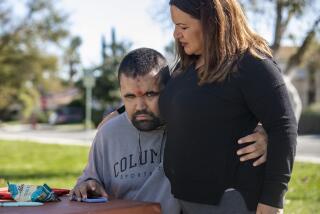Center Offers Healing From Head Injuries
- Share via
Norma Cowart still shudders when she recalls the sight of her 21-year-old son lying comatose in a hospital bed. She can still see the 16 different tubes doctors stuck in Greg’s body to save his life.
“It was almost inhumane,” Cowart said.
From the moment Greg Wheetley’s pickup truck crumpled against a light pole in Clairemont on July 14, 1986, doctors said his chances of surviving, let alone recovering from traumatic head injuries, were slim.
But on Tuesday, Wheetley walked around, chatted with guests and chaired a ribbon-cutting ceremony commemorating the opening of a head-injury rehabilitation center in Ramona. Wheetley, who two years ago couldn’t have held a pair of scissors to cut the ribbon, now talks eagerly about reviving his passion for the guitar.
Wheetley has defied the odds . . . with a little bit of help.
“A few years ago, somebody who had suffered the head injuries Greg received, if he survived, would probably have been sent to a nursing home or been institutionalized,” said Jim Cole, co-founder of NeuroCare, a private rehabilitation firm based in Concord, near San Francisco.
NeuroCare is one of several firms in the growing field of head-injury rehabilitation that is in the forefront of helping survivors and their families regain a normal and quality life.
Second Center Opened
The firm, which was established in 1986, recently opened its second San Diego County rehabilitation center. The facility, christened Tuesday as the Greg House in honor of Wheetley, joins other NeuroCare centers in Los Angeles, Phoenix and Portland.
Specialists in the field say there are nearly 700,000 traumatic head injuries a year. And though advanced surgical techniques save the lives of many of these people, they are often left with intellectual, physical and behavioral problems that often go unnoticed by friends, Cole said.
“One of the biggest problems is because these people look OK after their accidents, people assume these people are OK,” Cole said, pointing to Wheetley, who, dressed in a navy blue blazer and a paisley tie, shows no visible signs of his near-fatal accident. “They try to go back to jobs or back to school but end up failing. And that’s a tremendous blow to their fragile self-esteem. That’s why they call (head injuries) the silent epidemic.”
Cole referred to 1981 as the year when the need for medical programs allowing head-injury survivors to gradually return to society was recognized.
Four Programs Existed
Only four such programs, called post acute rehabilitation, existed nationwide in 1981. Joe Maurer, president of the Southern California Head Injury Foundation, estimates there are now nearly 350-400 such programs.
The volunteer foundation, which provides services such as an information and referral system, network of support groups and legislative lobbyists, was established to help improve the quality of life for head-injury survivors and their families, Maurer said.
But many patients, because of the extent of their injuries, suffer from loss of coordination and from emotional rages that prevent them from participating in programs that could reintroduce them to society, Cole said. The NeuroCare facilities try to counter that by helping patients overcome their behavioral problems.
At a cost of $525 a day, a team of therapists--including behavioral, speech and physical--work with patients on an individual basis, 24 hours a day, 7 days a week in a home-like environment, said NeuroCare special assistant Moira Hogan.
Though the cost may seem prohibitive, Hogan said that over the long term, it is cheaper than the cost required for institutionalizing a patient or keeping a person in a nursing home. “What’s important is that this program provides the individual a chance to become self-sufficient again,” she said.
Confined to Wheelchair
“When Greg first came to us, he was confined to his wheelchair,” said David Jolander, a behavioral specialist who worked on a daily basis with Wheetley. “And he would get angry and frustrated so easily because he couldn’t do the things he normally did or because he couldn’t remember anything.”
Jolander said Wheetley practiced relaxation techniques, such as deep breathing, for five minutes at a time. “We would use an ordinary kitchen timer. And at first, trying to keep his attention for even a short period of time like that was difficult.”
After seven months of such treatment, Wheetley learned to control his behavior and started participating in NeuroCare’s community-entry program to re-learn everyday living skills. Though still receiving treatment on an out-patient basis, Wheetley can now live with his parents in Clairemont.
The ultimate goal, said Wheetley, who was an apprentice pipe fitter before his accident, is to become self-sufficient. And, of course, play the guitar.
More to Read
Sign up for Essential California
The most important California stories and recommendations in your inbox every morning.
You may occasionally receive promotional content from the Los Angeles Times.













